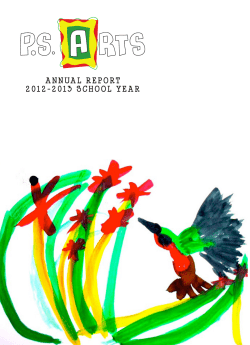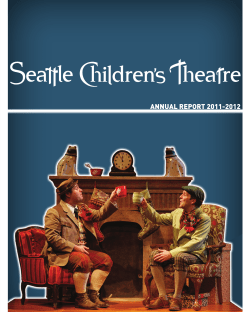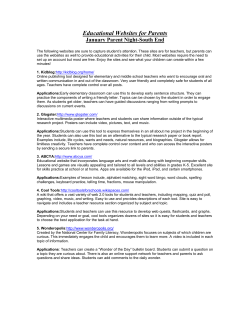
S Teaching The Science Process Skills
HOW CAN WE U N D E R S TA N D OUR W AT E R R E S O U R C E S ? Teaching The Science Process Skills What Are the Science Process Skills? attitude is a respect for the methods and S values of science. These scientific methods and cience and teaching students about values include seeking to answer questions science means more than scientific knowledge. There are three dimensions of science that are all important. The first using some kind of evidence, recognizing the importance of rechecking data, and understanding that scientific knowledge and theories of these is the content of science, the basic concepts, and our scientific knowledge. This is the dimension of science that most people first think about, and it is certainly change over time as more information is gathered. S IX B ASIC P ROCESS S KILLS very important. The other two important dimensions of science in addition to science knowledge are processes of doing science and scientific attitudes. The The science process skills form the foundation for scientific methods. There are six basic science process skills: processes of doing science are the science • Observation process skills that scientists use in the process • Communication of doing science. Since science is about asking • Classification questions and finding answers to questions, • Measurement these are actually the same skills that we all use in our daily lives as we try to figure out everyday questions. When we teach students • Inference • Prediction to use these skills in science, we are also These basic skills are integrated together when teaching them skills that they will use in the scientists design and carry out experiments future in every area of their lives. or in everyday life when we all carry out fair The third dimension of science focuses on the characteristic attitudes and dispositions of test experiments. All the six basic skills are important individually as well as when they are integrated together. science. These include such things as being curious and imaginative, as well as being The six basic skills can be put in a logical enthusiastic about asking questions and order of increasing sophistication, although solving problems. Another desirable scientific even the youngest students will use all of the TEACHING THE SCIENCE PROCESS SKILLS 6/5 HOW CAN WE U N D E R S TA N D OUR W AT E R R E S O U R C E S ? skills alongside one another at various times. grade includes content from all areas of In the earliest grades students will spend a science, organized in strands across these larger amount of time using skills such as grade levels, the science process skills SOL observation and communication. As students falls in the Scientific Investigation, Reasoning, get older they will start to spend more time and Logic strand. For grades 7–12 (Life using the skills of inference and prediction. Science, Physical Science, Earth Science, Classification and measurement tend to be Biology, Chemistry, then Physics) the SOL are used across the grade levels more evenly, no longer organized in vertical strands, but the partly because there are different ways to do first SOL at each of these grade levels still classifying, in increasingly complex ways, and defines the science process skills to be taught because methods and systems of measuring and practiced at that grade level. For all grade must also be introduced to children gradually levels K – 12, the intention is that the science over time. process skills be taught and practiced by students in the context of the content SOL Integrating the basic science process skills together and gradually developing abilities to design fair tests is increasingly emphasized in successive grade levels, and is an expectation of students by fourth grade. The Virginia for that grade level. Students will work on different content areas of science during the year, and all year long they will continue to use and develop further the science process skills for their grade level. Standard of Learning (SOL) 4.1 for fourthgraders includes, for example, creating hypotheses and identifying and manipulating S CIENCE B EGINS W ITH O BSERVATION variables in simple experiments. At this level, Observing is the fundamental science process the students are beginning to really ask and skill. We observe objects and events using answer their own questions in a scientific all our five senses, and this is how we learn sense. The following Designing an Experiment about the world around us. The ability to and Analyzing Experimental Data sections will make good observations is also essential to focus on using the integrated science process the development of the other science process skills to design experiments and reach skills: communicating, classifying, measuring, conclusions. inferring, and predicting. The simplest obser- In the Virginia Standards of Learning, the first science SOL (x.1) at every grade level K – 12 tells which of the science process skills should be introduced and emphasized at that grade level. For grades K–6, where the SOL at each vations, made using only the senses, are qualitative observations. For example, the leaf is light green in color or the leaf is waxy and smooth. Observations that involve a number or quantity are quantitative observations. For TEACHING THE SCIENCE PROCESS SKILLS 6/6 HOW CAN WE U N D E R S TA N D OUR W AT E R R E S O U R C E S ? example, the mass of one leaf is five grams O BSERVATION AND C OMMUNICATION G O H AND IN H AND or the leaves are clustered in groups of five. Quantitative observations give more precise As implied already, communication, the information than our senses alone. second of the basic science process skills, Not surprisingly, students, especially younger goes hand in hand with observation. Students children, need help in order to make good have to communicate in order to share their observations. Good, productive observations observations with someone else, and the are detailed and accurate written or drawn communication must be clear and effective descriptions, and students need to be promp- if the other person is to understand the ted to produce these elaborate descriptions. information. One of the keys to communicating The reason that observations must be so full of effectively is to use so-called referents, refer- detail is that only then can students increase ences to items that the other person is already their understanding of the concepts being stud- familiar with. For example, we often describe ied. Whether students are observing with their colors using referents. We might say sky five senses or with instruments to blue, grass green, or lemon yellow to describe aid them, we can guide them to make better particular shades of blue, green, or yellow. more detailed descriptions. We can do this The idea is to communicate using descriptive by listening to students’ initial observations words for which both people share a common and then prompting them to elaborate. For understanding. Without referents, we open the example, if a student is describing what he or door to misunderstandings. If we just say hot she can see, they might describe the color of an or rough, for example, our audience might have object but not its size or shape. A student a different idea of how hot or how rough. If a might describe the volume of a sound but not student is trying to describe the size of a its pitch or rhythm. We can prompt students to pinecone they might use the size of his or her add details to their descriptions no matter shoe as a referent. The pinecone could be which of the five senses they are using. There either larger or smaller than his shoe. are other ways that we can prompt students to make more elaborate descriptions. For example, if something is changing, students should include, before, during, and after appearances in their observations. If possible, students should be encouraged to name what is being observed. The additional science process skill of measuring is really just a special case of observing and communicating. When we measure some property, we compare the property to a defined referent called a unit. A measurement statement contains two parts, a number to tell us how much or how many, and a name for TEACHING THE SCIENCE PROCESS SKILLS 6/7 HOW CAN WE U N D E R S TA N D OUR W AT E R R E S O U R C E S ? the unit to tell us how much of what. The out backbones. A binary classification can also use of the number makes a measurement a be carried out using more than one property at quantitative observation. once. Objects in one group must have all of Students can communicate their observations verbally, in writing, or by drawing pictures. the required properties; otherwise they will belong to the other group. Other methods of communication that are A multi-stage classification is constructed by often used in science include graphs, charts, performing consecutive binary classifications maps, diagrams, and visual demonstrations. on a set of objects and then on each of the ensuing subsets. The result is a classification system consisting of layers or stages. A C LASSIFYING I NTO G ROUPS Students in the early grades are expected to be able to sort objects or phenomena into groups based on their observations. Grouping objects or events is a way of imposing order based on similarities, differences, and interrelationships. This is an important step towards a better multi-stage classification is complete when each of the objects in the original set has been separated into a category by itself. The familiar classifications of the animal and plant kingdoms are examples of multi-stage class-ifications. A useful activity for younger children could be to create a multi-stage clas- understanding of the different objects and sification of some local animals using physical events in the world. and/or behavioral similarities and differences. There are several different methods of classification. Perhaps the simplest method is serial ordering. Objects are placed into rank order based on some property. For example, students can be serial ordered according to height, or different breakfast cereals can be serial ordered according to number of calories per serving. Two other methods of classification are binary classification and multistage classification. In a binary classification system, a set of objects is simply divided into two subsets. This is usually done on the basis of whether each object has or does not have a particular property. For The Virginia Science SOL match the different classification skills to the different grade levels. In kindergarten, children are expected to sequence a set of objects according to size. The kindergarteners are also expected to separate a set of objects into two groups based on a single physical attribute. (See Science SOL K.1.) In first grade, students should classify and arrange both objects and events according to various attributes or properties (1.1). In second grade, students should classify items using two or more attributes (2.1). In third grade, students should classify objects example, animals can be classified into two groups: those with backbones and those with- with similar characteristics into at least two sets and two subsets, and they should also TEACHING THE SCIENCE PROCESS SKILLS 6/8 HOW CAN WE U N D E R S TA N D OUR W AT E R R E S O U R C E S ? sequence natural events chronologically (3.1). asking students questions about their observa- In fourth grade, students should classify tions we can encourage the students to think data to create frequency distributions (4.1); about the meaning of the observations. in fifth grade, students should identify rocks, Thinking about making inferences in this way minerals, and organisms using a classification should remind us that inferences link what key (5.1); and in sixth grade, students should has been observed together with what is develop a classification system based on already known from previous experiences. We multiple attributes (6.1). use our past experiences to help us interpret our observations. M AKING I NFERENCES AND P REDICTIONS Often many different inferences can be Unlike observations, which are direct evidence made based on the same observations. Our gathered about an object, inferences are expla- inferences also may change as we make nations or interpretations that follow from the additional observations. We are generally observations. For example, it is an observation more confident about our inferences when to say an insect released a dark, sticky liquid our observations fit well with our past exper- from its mouth, and it is an inference to state, iences. We are also more confident about the insect released a dark, sticky liquid from its our inferences as we gather more and more mouth because it is upset and trying to defend supporting evidence. When students are trying itself. When we are able to make inferences, to make inferences, they will often need to and interpret and explain events around us, go back and make additional observations we have a better appreciation of the environ- in order to become more confident in their ment around us. Scientists’ hypotheses about inferences. For example, seeing an insect why events happen as they do are based on release a dark, sticky liquid many times inferences regarding investigations. whenever it is picked up and held tightly will increase our confidence that it does this Students need to be taught the difference because it is up-set and trying to defend itself. between observations and inferences. They need to be able to differentiate for themselves the evidence they gather about the world as observations and the interpretations or inferences they make based on the observations. We can help students make this distinction by first prompting them to be detailed and descriptive in their observations. Then, by Sometimes making additional observations will reinforce our inferences, but sometimes additional information will cause us to modify or even reject earlier inferences. In science, inferences about how things work are continually constructed, modified, and even rejected based on new observations. TEACHING THE SCIENCE PROCESS SKILLS 6/9 HOW CAN WE U N D E R S TA N D OUR W AT E R R E S O U R C E S ? Making predictions is making educated guesses about the outcomes of future events. We are forecasting future observations. The ability to make predictions about future events R ESOURCES • A Key to Science Learning. Yockey, J. A. (2001). Science & Children, 38(7), 36-41. allows us to successfully interact with the An article at the elementary school level, environment around us. Prediction is based describing a simple writing technique to help on both good observation and inferences made students communicate the important science about observed events. Like inferences, predic- concepts they have learned. tions are based on both what we observe and also our past experiences the mental models • Centimeters, Millimeters, & Monsters. we have built up from those experiences. So, Goldston, J. M., Marlette, S., & Pennington, predictions are not just guesses! Predictions A. (2001). Science & Children, 39(2), 42-47. based on our inferences or hypotheses about events give us a way to test those inferences or hypotheses. If the prediction turns out to be correct, then we have greater confidence in our inference/hypothesis. This is the basis of the scientific process used by scientists who are asking and answering questions by integrating together the six basic science process skills. An article at the elementary school level, describing a humorous way to teach metric units. • Drawing on Student Understanding. Stein, M., McNair, S., & Butcher, J. (2001). Science & Children, 38(4), 18-22. This article, at the elementary school level, In summary, successfully integrating the science process skills with classroom lessons and field investigations will make the learning experiences richer and more meaningful for students. Students will be learning the skills of science as well as science content. The describes how children can use drawings to communicate their understanding of animals. In the process, student learning about the animals is reinforced, as the children are encouraged to think deeply about what they know and have observed. students will be actively engaged with the science they are learning and thus reach a deeper understanding of the content. Finally • Learning and Assessing Science Process active engagement with science will likely lead Skills. Rezba, R. J., Sprague, C. S., Fiel, R. students to become more interested and have L., Funk, H. J., Okey, J. R., & Jaus, H. H. more positive attitudes towards science. (3rd Ed.). (1995). Dubuque, IA: Kendall/Hunt Publishing Company. TEACHING THE SCIENCE PROCESS SKILLS 6/10 HOW CAN WE U N D E R S TA N D OUR W AT E R R E S O U R C E S ? A comprehensive text describing both the basic science process skills and the integrated science process skills in detail, along with suggestions of activities incorporating the skills with science content and appropriate assessment methods. • Oh Say Can You See ? Checkovich, B. H., & Sterling, D. R. (2001). Science & Children, 38(4), 32-35. An article at the elementary school level, describing a simple strategy for improving students’ observation skills. • Teaching & Learning The Basic Science Skills: Videotape Series. Rezba, R. J. (1999). Office of Elementary and Middle School Instructional Services, Virginia Department of Education, P.O. Box 2120, Richmond, VA 23218-2120. Call media office for copies of videotapes at 804-225-2980. • When a Hypothesis is NOT an Educated Guess. Baxter, L. M., & Kurtz, M. J. (2001). Science & Children, 38(7), 18-20. An article at the elementary school level, discussing the difference between making a prediction (an educated guess about the outcome of a test) and forming a hypothesis (an educated guess about why the outcomes occurred). TEACHING THE SCIENCE PROCESS SKILLS 6/11 TEACHING THE SCIENCE PROCESS SKILLS 6/12
© Copyright 2025
















